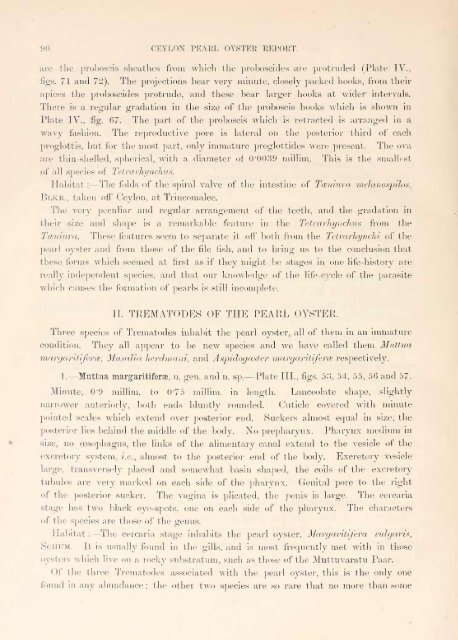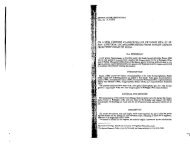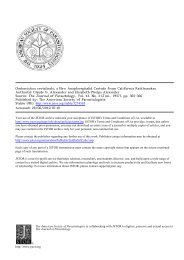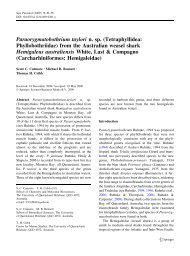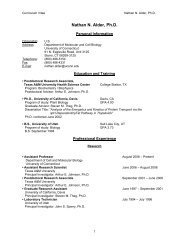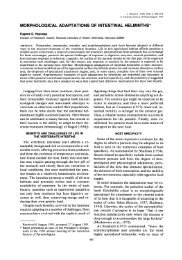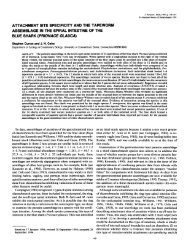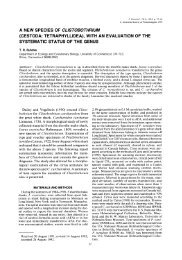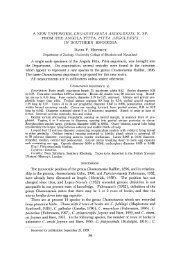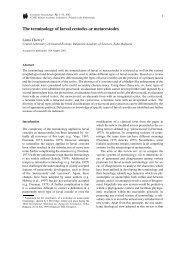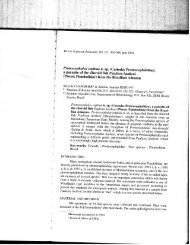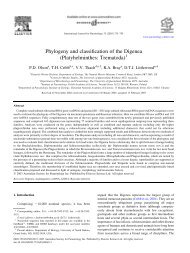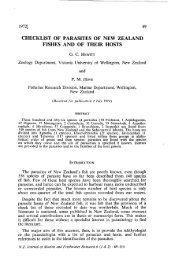PEARL OYSTER FISHERIES MARINE BIOLOGY OF CEYLON,
PEARL OYSTER FISHERIES MARINE BIOLOGY OF CEYLON,
PEARL OYSTER FISHERIES MARINE BIOLOGY OF CEYLON,
You also want an ePaper? Increase the reach of your titles
YUMPU automatically turns print PDFs into web optimized ePapers that Google loves.
90 <strong>CEYLON</strong> <strong>PEARL</strong> <strong>OYSTER</strong> REPORT.are the proboscis sheathes from which the proboscidesarc protruded (Plate IV.,figs. 71 and 72).The projections bear very minute, closely packed hooks, from theirapices the proboscides protrude, and these bear larger hooks at wider intervals.There is a regular gradation in the size of the proboscis hooks which is shown inPlate IV., fig. 67. The part of the proboscis which is retracted is arranged in awavy fashion. The reproductive pore is lateral on the posteriorthird of eachproglottis, but for the most part, only immature proglottides were present. The ovaare thin-shelled, spherical, with a diameter of 0'0039 millim. This is the smallestof all species of Tetrarhynclms.Habitat: The folds of the spiral valve of the intestine of Tceniura melanospilos,Blkr,, taken off Ceylon, at Trincomalee.The very peculiar and regular arrangement of the teeth, and the gradation intheir size and shapeis a remarkable feature in the Tetrarhynchus from theTceniura. These features seem to separateit off both from the Tetrarhynchi of thepearl oyster and from those of the file fish, and to bring us to the conclusion thatthese forms which seemed at first as if they might be stages in one life-history arereally independent species, and that our knowledge of the life-cvcle of the parasitewhich causes the formation of pearls is still incomplete.II.TREMATODES <strong>OF</strong> THE <strong>PEARL</strong> <strong>OYSTER</strong>.Three species of Trematodes inhabit the pearl oyster,all of them in an immaturecondition.They all appear to be new speciesand we have called them MuttuamargaritiferoB, Musalia herclmani, and Aspidogaster margaritiferce respectively.1. Muttua marguritiferae, n. gen. and n. sp. Plate III., figs. 53, 54, 55, 56 and 57.Minute, 0'9 millim. to 0'75 millim. inlength. Lanceolate shape, slightlynarrower anteriorly, both ends bluntly rounded. Cuticle covered with minutepointed scales which extend over posterior end. Suckers almost equal in size, theposterior lies behind the middle of the body. No prepharynx. Pharynx medium insize, no oesophagus, the links of the alimentary canal extend to the vesicle of theexcretory system, i.e., almost to the posterior end of the body. Excretory vesicleLarge, transversely placed and somewhat basin shaped, the coils of the excretorytubules are very marked on each side of the pharynx. Genital pore to the rightof the posterior sucker. The vagina is plicated, the penis is large.The cercariastage lias two black eye-spots, one on each side of the pharynx. The charactersof the species are those of the genus.Habitat: The cercaria stage inhabits the pearl oyster, Margaritifera vulgaris,ScHUM. It is usually found in the gills, and is most frequently met with in thoseoysters which live on a rocky substratum, such as those of the Muttuvaratu Paar.Of the three Trematodes associated with the pearl oyster,this is the only onefound in any abundance; the other two species are so rare that no more than some


